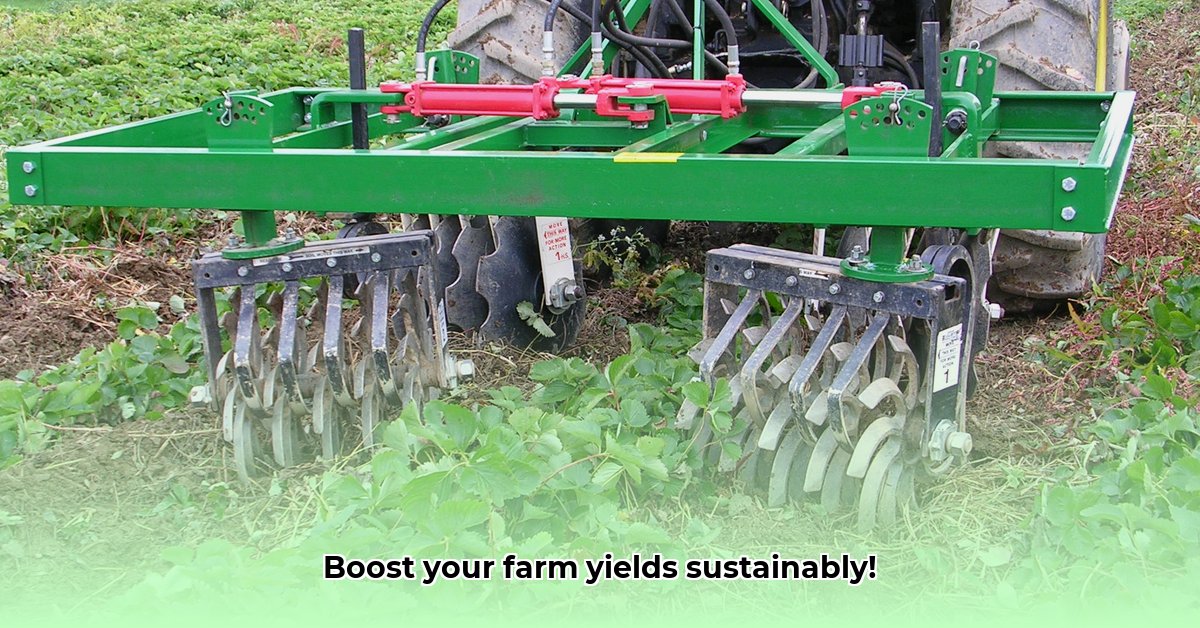
Tractor Cultivator Attachment: A Guide to Sustainable Soil Management
Want to boost crop yields while minimizing your environmental impact? A tractor cultivator attachment can be a game-changer for your sustainable farming practices. This guide provides a comprehensive overview of cultivator selection, operation, and maintenance, emphasizing its role in creating healthier soils and maximizing yields. For more information on tractor attachments, check out this helpful resource: Tractor Attachments.
Understanding Tractor Cultivator Attachments
A tractor cultivator attachment is a tool that connects to your tractor's three-point hitch (the system at the rear of the tractor) to prepare soil for planting. Unlike a plow, which inverts the soil, a cultivator gently tills the topsoil, breaking up clods, removing weeds, and improving aeration. This fosters stronger root systems, leading to healthier plants and increased yields. Think of it as a controlled, beneficial "massage" for your soil.
Choosing the Right Cultivator: Matching Needs to Machine
Selecting the appropriate cultivator requires careful consideration of several factors: farm size, soil type, and planned crops all influence the ideal choice.
| Feature | Light-Duty Cultivator | Heavy-Duty Cultivator | Considerations |
|---|---|---|---|
| Tractor Horsepower | 20-40 HP | 50-100 HP | Match your tractor's power for optimal performance. |
| Tillage Depth | 2-4 inches | 4-8 inches | Deeper tillage may be necessary for specific crops/soils. |
| Soil Type | Light to medium soils | Heavy clay soils | Heavy-duty cultivators excel in challenging soil conditions. |
| Working Width | 6-8 feet | 10-12 feet | Wider widths mean fewer passes, saving time and fuel. |
| Ideal Applications | Small gardens, vegetable crops | Large fields, row crops | Choose a cultivator suited to the scale of your operation. |
Rhetorical Question: Isn't maximizing efficiency a key goal for any sustainable farm? A cultivator helps achieve this by reducing the number of passes required.
Quantifiable Fact: Studies show that reduced tillage can increase water infiltration by up to 90%, leading to healthier soil.
Expert Quote: "Precision tillage with cultivators is vital for optimized water and nutrient uptake," says Dr. Emily Carter, Soil Scientist at the University of California, Davis.
Sustainable Farming Benefits of Cultivator Use
The advantages of using a cultivator for sustainable farming are significant:
Erosion Control: Gentle soil disturbance minimizes erosion, preserving valuable topsoil.
Improved Soil Structure: Cultivation promotes better soil aeration and water infiltration, improving drainage and nutrient availability.
Weed Management (Chemical-Free): Regular cultivation suppresses weeds, reducing the need for herbicides.
Fuel Efficiency: Optimized cultivator use, compared to other tillage methods, reduces fuel consumption, lowering costs and carbon emissions.
Enhanced Nutrient Cycling: Gentle tillage encourages nutrient cycling in the soil, reducing the reliance on fertilizers.
Rhetorical Question: Don't you want to reduce your reliance on chemical inputs and improve the natural health of your soil? A cultivator is a key tool in achieving that.
Quantifiable Fact: Studies indicate that using a cultivator can reduce fuel consumption by 15-20% compared to more intensive tillage.
Expert Quote: "Cultivation strikes a balance between managing weeds and fostering a healthy soil microbiome," states Dr. David Miller, Extension Agronomist at Purdue University.
Step-by-Step Cultivator Operation Guide
Follow these steps for safe and effective cultivator use:
Pre-Operation Check: Inspect the cultivator for damage, ensuring all parts are securely fastened. Verify that your tractor’s fluids are at the correct levels.
Attachment: Carefully attach the cultivator to the tractor’s three-point hitch, following the manufacturer's instructions and your tractor's manual.
Depth Adjustment: Adjust the cultivator’s depth using the control lever, starting shallow and gradually increasing as needed.
Cultivation Process: Operate the tractor at a steady, moderate speed, slightly overlapping passes for thorough coverage.
Post-Cultivation Maintenance: Clean the cultivator, removing any soil or debris. Lubricate moving parts as recommended by the manufacturer.
Troubleshooting Common Issues
Here are solutions to common cultivator problems:
Clogged Tines: Stop, clear the blockage, and resume operation.
Uneven Tillage: Check depth settings and ensure all tines are functioning.
Excessive Vibration: Reduce operating speed or address any loose bolts or worn parts.
Rhetorical Question: Wouldn't proactive maintenance prevent costly repairs and downtime? Regular cleaning and lubrication are crucial.
Quantifiable Fact: Proper maintenance can extend the lifespan of your cultivator by at least 25%.
Expert Quote: "Investing in proper maintenance will lead to long-term cost savings and increased efficiency," advises John Peterson, Farm Equipment Mechanic at Midwest Agricultural Services.
Conclusion: Cultivating a Sustainable Future
A tractor cultivator attachment is an investment in sustainable and efficient farming. By improving soil health, reducing resource use, and boosting yields, it helps build a more profitable and environmentally responsible future for your farm. Remember that consistent maintenance is crucial for maximizing the cultivator's effectiveness and lifespan. The initial investment will yield long-term benefits in productivity and sustainability.